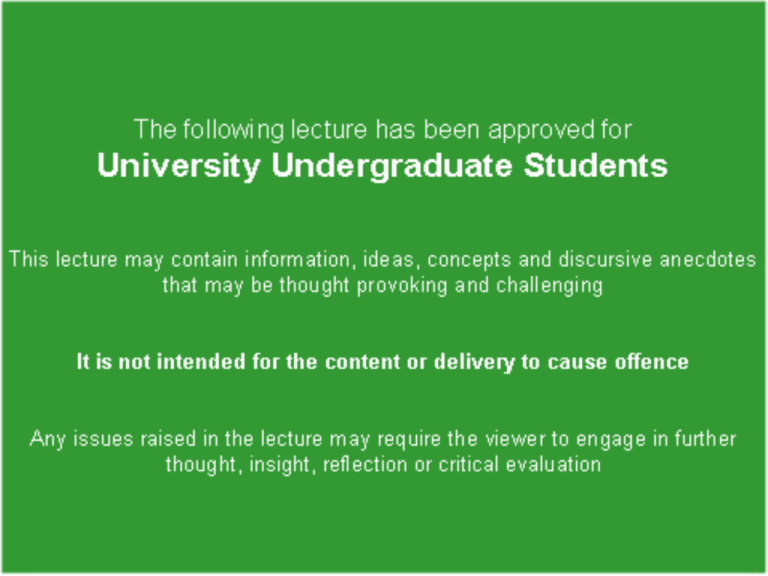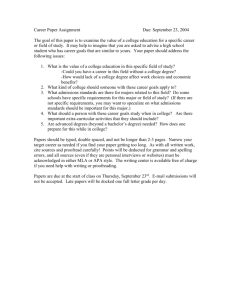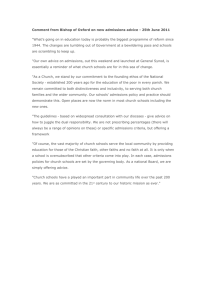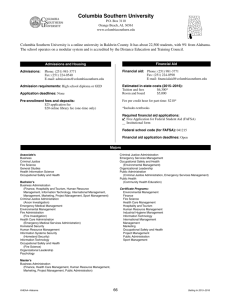Epidemiology Textbook - Faculty of Health, Education and Life
advertisement

Introduction to Epidemiology Craig Jackson Prof. Occupational Health Psychology Head of Psychology BCU Occupational Epidemiology “People who work sitting down get paid more than people who work standing up” Ogden Nash (1902 - 1971) Aims • Highlight basic concepts of “cause and effect” • Describe basic data needed for epidemiological investigation • Demonstrate pictorial epidemiology • Prove epidemiology is not the sole preserve of statisticians • Epidemiology is achievable to anyone with PC and web connection • Show that epidemiology can be small, medium or large scale • Although uses objective statistics, interpretation still subjective • Calculations: incidence rate, death rate, fatality rate etc. Learning Outcomes • Identify sources of epidemiological data and relate these to the occupational setting. • Have a critical insight into the language, methodological approaches and the nature of findings associated with epidemiological investigations. • Reflect on how epidemiological data may inform a dutyholder’s management of occupational health and hygiene issues. Descriptive Epidemiology - Months Work-Related ill-health in UK • 33 Million days lost per year • Males lose more working days than females • Days lost increase with age • Low managerial / professionals have highest rate of absence • Most sickly occupations: Health & Social welfare Public Admin. Construction Teaching • Dress-makers have youngest age-at-death of any occupation Work-Related ill-health in UK Work-Related ill-health in UK North-South Divide? Self-Reported Sickness Objective data? Objective interpretation? Objectives of Epidemiology Describe key features of descriptive data Understand: mean, mode, median, variance, standard deviation Calculate: mean, mode, median ratios proportions rates mortality rates prevalence & incidence Understand: tables, charts, plots Understand: public health surveillance Introduction Basic science of public health Quantitative Based on probability statistics sound research Uses “causal reasoning” Practical common sense Introduction epi “on” or “upon” demos “people” or “mass” logos “study of” “Epidemiology is the study of the distribution and determinants of healthrelated states or events in specified populations, and the application of this study to the control of health problems.” Last 1988 TIME: annual, seasonal, daily, hourly PLACE: geographic variation, urban vs. rural, workplaces, schools PERSONAL: age, race, sex, class, occupation, behaviours Introduction Epidemiological info used to promote and protect public health Both science and public health come together “Applied Epidemiology” e.g. Monitoring communicable diseases in communities Dietary intake influencing development of cancers Effectiveness and impact of cholesterol awareness programmes Analyse historical and current data to find resource needs Introduction “Epidemiology” searched on BBCi on 4th Nov 2003 Introduction Who gets disease? (objective) Why do they get diseases? (conjecture) Study sick people and healthy people to determine crucial difference between those who get ill and those who do not RATES COMPARES BALANCES CONTRASTS NUMERATOR The no. of people to whom something happened e.g got sick DENOMINATOR The population at risk e.g.the entire population RIASS survey Comparison of yards by staff size: a) UK Yard population b) Survey sample Scaled up numbers Sample Nos Scaled up Population Nos Total No of reported Accidents 665 1862 Horse related 640 1792 No of yards reporting accidents 252 352 Required medical attention 318 996 A&E Attendances 213 596 Soft tissue injuries 364 1019 Fractures 86 240 Lacerations 62 174 Concussion 21 59 Accidents leading to sickness absence Resulting Days Sickness Absence Cost to industry based on min wage 261 730 7431 20807 From £1.05 million to 1.207 million Epi-derm / THOR The aim of the scheme is to determine the extent of occupational skin disease in UK industry and therefore to take steps to reduce the incidence of occupational disease and to monitor changes. Reports of cases of occupational skin disease from consultant dermatologists since 1993. Funded to continue collecting data for this work until end 2006. Produced valuable information on the incidence occupational skin disease, and on the agents responsible. of Epi-derm / THOR Approximately 188 members of the British Association of Dermatologists take part 22 are core reporters who report every month) 166 are sample reporters who are sampled at random and report for one month only each year. The major category of cases reported consists of contact dermatitis, followed by neoplasia (cancers) 1993 - 1999 total of 12,574 new cases of occupational skin disease were reported by consultant dermatologists 9937 of which were contact dermatitis (79% of total cases) What is an Epidemic? When there are significantly more cases of a disease than than past experience would have predicted Three Things Investigated in Epidemics 1) Person / Host 2) Place / Environment 3) Time of exposure and symptoms 2227 people exposed to something and 1522 of them died. What can we discover about this event? What is an Epidemic? 1. Person / Host • • Men, Women and children all at risk Majority were working men aged 18-50 2. Place / Environment • • All male cases were within 1 square mile of each other Climate was cold 2227 people exposed to something and 1522 of them died. 3. Time of exposure and symptoms • • Mid April Death occurred within hours of exposure What can we discover about this event? Personal Details Inherent Characteristics age, race, sex Acquired Characteristics marital status, immune status Activities occupation, leisure, drugs Domestic socio-economic status, GP access Try to break ill-health down into these categories Age and Sex are the most critical Age Single most important personal attribute Almost all health-related event or state varies with age Other factors are behind this association e.g. Susceptibility Exposure Latency / Incubation periods Physiological response Use narrow age groups to detect any patterns Age groups may not show enough detail Sex Males have higher rate of mortality and morbidity than females Genetic, Hormonal, Anatomical or other Inherent sex differences Differences effect physiological responses and susceptibility e.g. heart disease lower in pre-menopausal women (oestrogen levels) Sex also effects exposure levels and occupational ill-health e.g. Occupation, Task and Repetitive Strain Injury Determinants Causes or factors of incidence of ill-health Health-related states or events chronic disease injuries birth defects child health occupational health environmental health Specified Populations Exposures Others exposed Spread Interventions John Snow, Cholera, and the Broad Street Pump Mortality from Cholera in the districts of London, 9th Jul – 26th Aug 1854 John Snow, Cholera, and the Broad Street Pump Case Definition Set of standard criteria Decides if person has disease / state Objective Allows reliable comparisons across (i) time, (ii) people, (iii) areas Clinical criteria and limitations, symptoms, and signs Case Definition People can be classified as Cases Non-Cases Suspects ? + Hospital Admissions and World Cup 1998 Examine hospital admissions for range of diagnoses on days surrounding England's 1998 World Cup football matches Hospital admissions obtained from English hospital episode statistics Pop. Aged 15 – 64 years Admissions for • Acute MI • Stroke • Deliberate self harm • Road traffic injuries On match day and 2 days after match day Compared with admissions at the same time in 1997 and 1998 Carroll, D et al. 2002 Hospital Admissions and World Cup 1998 England's matches in the 1998 World Cup 15 June 22 June 26 June 30 June (England 2, Tunisia 0) (Romania 2, England 1) (Colombia 0, England 2) (Argentina 2, England 2) win lost win lost: penalties 4-2 Extracted hospital admissions data for acute myocardial infarction, stroke, deliberate self harm, and road traffic injuries among men and women aged 15 to 64 Games all took place in late evening Examined the same associations using only the two days after the match omitting the day of the match as the exposed condition Hospital Admissions and World Cup 1998 During the period of England's World Cup matches (15 June to 1 July) 81,433 emergency admissions occurred: 1348 662 856 3308 Day of match 1 day after 2 days after 3 days after 4 days after 5 days after (2%) for myocardial infarction (1%) for stroke (1%) for road traffic injury (4%) for deliberate self harm observed / expected admissions 91 / 72 88 / 72 91 / 71 76 / 74 71 / 74 83 / 72 actual – expected admissions 19 16 20 2 3 11 ARR 1.25 (0.99 to 1.57) 1.21 (0.96 to 1.57) 1.27 (1.01 to 1.61) 0.99 (0.77 to 1.27) 0.92 (0.71 to 1.19) 1.13 (0.89 to 1.43) Hospital Admissions and World Cup 1998 Admission diagnosis Within 2 days of win Within 2 days of 1-2 loss Within 2 days of loss on penalty P value M.I 0.99 0.89 - 1.11 0.91 0.78 - 1.07 1.25 1.08 - 1.44 0.007 Stroke 0.87 0.74 - 1.03 0.97 0.79 - 1.19 1.00 0.82 - 1.23 0.42 RTA 0.99 0.85 - 1.14 0.96 0.79 - 1.17 0.85 0.69 - 1.05 0.51 DSH 1.08 1.00 - 1.16 1.01 0.91 - 1.12 1.05 0.95 - 1.16 0.26 •Periods after a win (Tunisia, Columbia) and 1st first loss (Romania) were not associated with increased admissions • On match day, and two days after match against Argentina with a penalty shoot-out, admissions for acute MI increased by 25%. • No increases in admission were seen for any of the other diagnoses Hospital Admissions and World Cup 1998 Major environmental events, whether physical catastrophes or cultural disappointments, are capable of triggering myocardial infarction. If the triggering hypothesis is true, preventive efforts should consider strategies for dealing with the effects of acute physical and psychosocial upheavals. “Perhaps the national lottery or even the penalty shoot-out should be abandoned on public health grounds.” Limitations: Harvesting effect? Reporting tendency? Sudden deaths? Modern Example: AIDS Personal Details 1981 Cluster of 5 cases of rare pneumonia All 5 were young males Aged between 29-36 2 of the 5 reported frequent homosexual contact All 5 used poppers Modern Example: AIDS Location Details 5 cases were in Los Angeles Similar cases in NY and SF Time Details All 5 deaths between Oct 1980 – May 1981 4 weeks after, 67 more cases reported Descriptive Epidemiology - Years Descriptive Epidemiology - Seasonal Descriptive Epidemiology - Days Fatalities associated with Tractor injuries, by day of week, Georgia: 1971-1981 Descriptive Epidemiology - Regional Descriptive Epidemiology - Workspaces Incidence Rate No. of new cases of disease over time period Incidence rate = No. of population at risk Prevalence Rate No. of cases of disease at a given time Prevalence rate = No. of total population Standard Mortality Ratio Observed number of deaths SMR = Expected number of deaths 6 deaths (per 1000) for truckers 3 = 2 deaths (per 1000) for all occupations Risk Ratios “Risk Ratios” can inform how “risky” certain exposures / behaviours are Implications for likelihood of developing certain diseases “Risky” behaviours can be avoided or prohibited Incidence of lung cancer among smokers = R.R Incidence of lung cancer among non smokers 600 cases (per 1000) for smokers = 24 25 cases (per 1000) for non-smokers Case Fatality Why are people more scared of a diagnosis of Cancer than Arthritis? Some diseases have a higher Fatality Rate No. of deaths by disease in timeframe Fatality Rate = X 100 No. of cases of the disease in timeframe 60 deaths due to SARS in last month 69.7% X 100 86 cases of SARS recorded in last month Crude Death Rate No. of deaths in calendar year C.D.R = X 1000 No. of population at mid-year Expressed as Deaths per 1000 500,000 deaths in calendar year 8.3 deaths / 1000 = X 1000 60,000,000 population at mid-year Why might different regions of the UK have different CDRs? Case Control Study: Lung Cancer Cases have Lung Cancer + Smoking Exposure Controls could be other hospital patients (other disease) or “normals” Matched Cases & Controls for age & gender Smoking years of Lung Cancer cases and controls (matched for age and sex) Cases n=456 Smoking years 13.75 (± 1.5) Controls n=456 6.12 (± 2.1) F 7.5 P 0.04 Cohort Study: Mobile phones and Ill-Health Subjects classified into 2 (or more groups) e.g. exposed vs non exposed End point: groups compared for health status Comparison of general health between users and non-users of mobile phones ill healthy mobile phone user 292 108 400 non-phone user 89 313 402 381 421 802 Age groups Sex Economics of Scale - Solway Harvester Photo courtesy of Dr Gordon Baird Solway Harvester Numerical % Isle of Whithorn 7/300 2.3 Wigtownshire 7/20,000 0.03 London 7/6,000,000 0.00001 7 people from Wigtownshire . . . . . . . . . . Equivalent to 120,000 people from London Risk & Odds Ratios: Gulf War Syndrome 2 x 2 Tables: Diabetes over 2 years in Builders Epidemiology of Birmingham? Health and Safety Executive (THOR) www.hse.gov.uk/statistics Office of National Statistics www.statistics.gov.uk Traditional Industries New and Emerging Industries Environmental Aspects Transport Features Migrant Populations Recommended Journal Reading 1 Carroll D, Davey Smith G, Sheffield D, Shipley MJ, and Marmot MG. (1995). Pressor reactions to psychological stress and prediction of future blood pressure: data from the Whitehall II study. BMJ; 310: 771-775. Carroll D et al., (2002) Admissions for myocardial infarction and World Cup football: database survey. BMJ. Dec 21; 325: 1439-42. Chen C, David AS, Nunnerley H, Michell M, Dawson JL, Berry H, Dobbs J, and Fahy T. (1995). Adverse life events and breast cancer: case-control study. BMJ; 311: 1527-1530. Recommended Journal Reading 2 Kivimäki M, Leino-Arjas P, Luukkonen R, Riihimäki H, Vahtera J, and Kirjonen J. (2002). Work stress and risk of cardiovascular mortality: prospective cohort study of industrial employees. BMJ; 325: 857. Levenstein S. (1998). Stress and peptic ulcer: life beyond helicobacter. BMJ; 316: 538-541. Meyer JD. et al. (2000) Occupational contact dermatitis in the UK: a surveillance report from EPIDERM and OPRA. Occupational Medicine; 50(4): 265-273. Recommended Book Reading Altman, D.G. “Designing Research”. In: Altman, D.G., (ed.) Practical Statistics For Medical Research. London, Chapman and Hall, 1991; 74-106. Bland, M. “The design of experiments”. In: Bland, M., (ed.) An introduction to medical statistics. Oxford, Oxford Medical Publications, 1995; 5-25. Daly, L.E., Bourke, G.J. “Epidemiological and clinical research methods”. In: Daly L.E., Bourke, G.J., (eds.) Interpretation and uses of medical statistics. Oxford, Blackwell Science Ltd, 2000; 143-201. Fitzpatrick M. (2002). Work Stress: The Making of a Modern Epidemic. Milton Keynes Open University Press. Jackson, C.A. “Study Design” & “Sample Size and Power”. In: Gao Smith, F. and Smith, J. (eds.) Key Topics in Clinical Research. Oxford, BIOS scientific Publications, 2002.







